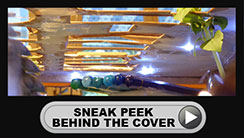
by Gareth Jefferies, Alpine Property
I don't suppose living in the Alps is that great from an Ecological perspective. Though as time goes on we are learning (actually, being slowly forced) to reduce our carbon footprint on the environment. Not many people think about this though, even with the government's attempts to help (see the DPE labels). I've written about it in the past too (An Eco-Chalet in the Alps). Despite this I did have a customer say to me recently "I'm only interested in building a new place...for eco reasons", maybe as time goes on it will happen more often? Though I'm not sure that building from scratch is that eco-friendly, despite the fact the heating bills will be less. The carbon footprint from the new materials might well outweigh the long-term benefits.
I've been living in my house for 14 years and have only got around to upgrading the last remaining single glazed windows this winter. It's never been a priority for me as I'm well aware that the pay back won't happen for 20 or more years. I took the opportunity to take some infrared pictures to show the difference before and after. It was a bit of an eye opener. Not the difference the windows made but how much heat my house is giving off!
The first photo shows my house on a cold day (-7C), the ground floor is 60cm of solid (stone and rubble) construction with no insulation. The upstairs of my property was insulated when it was renovated 30 years ago. They use hollow bricks with a small amount of mineral wool insulation stuffed between them. There is no vapour barrier and externally the walls are wood clad. The shocking thing here is the walls are 10C. The single-glazed windows are obvious on the picture and are only slightly colder (15C) than the inside temperate at the time (19C).

I live in a semi-detached house. The other side of the property is a holiday home and was unoccupied at the time. The difference between the two can be seen above and is stark.
I have a few before (top) and after (bottom) photos of my house here. The first one shows the replacement front door.


These pair show the windows before (top) and after (bottom).


The rear of my house has been renovated by us in the last few years. We added double glazed windows, some thermal plasterboard to the internal walls and some insulation to the floor. The room was barely habitable in the winter and now it is just fine. The heater is the same size as before! The difference is obvious on this picture. The window glass is about -4C and the walls are mostly above freezing. The weak point is the window frames.

I live next to a newly built house. It's a "kit" house which is becoming the norm around here. The structure and walls are made in a factory, the house itself is then constructed quickly on site. The difference in economy is obvious.

The outside of the house is pretty much at ambient temperature (it is not letting out any heat). There is one small issue around the garage door but that is about it! I mentioned this property in a blog I wrote a few years ago about building a chalet in the Alps. I've quizzed the owners of new properties like this and the energy savings are real. They are generally heated with electricity that powers an air source heat pump. The overall energy costs for a house like this are 30% of mine. So where I pay 300€/month for the heat+light for my house they pay 100€/month for the same sized building.
This traditional framed method of construction can be seen here:

A wood frame sits on top of a concrete base. The wood frame and the wall panels are made in a factory, insulation is added on site. The concrete is insulated inside and out and clad to taste. It's an expensive and materials hungry form of construction. You can see a nice cutaway below. Stone cladding, beneath that 40cm of insulation, 40cm of concrete and some more insulation and plasterboard inside. No expense spared!

SIP Panels (Structural Insulated Panels)
SIP's are less materials intensive (and therefore cheaper), as well or better insulated as any alternative, quicker to construct (and therefore cheaper). I've noticed a few houses being constructed with these techniques around Morzine. Mostly by the aforementioned ECSUS Design using Kingspan products. In fact they have been building a number of chalets around the Haute Savoie. In the past their chalets have been quite simple. You can see an example of this on my article "how to build your own chalet" and in the video below. This doesn't always have to be the case, as seen here .... https://www.youtube.com/chalet-build-montiond and on this new build in Morzine.
Resources for renovations
Everyone knows that the first thing to insulate is your roof, after that you need to eliminate draughts. More often than not if you do a cost benefit calculation for making further improvements to a house the investment is such that any pay-back will be 10 years plus. Building costs in the Alps are such that the pay back can be even more. Here are a few UK specific resources that might help.
http://www.energysavingtrust.org.uk/home-energy-efficiency/energy-efficient-windows
http://www.energysavingtrust.org.uk/home-insulation/solid-wall
This is an interesting product for helping to insulate an older home. It's an aerated plaster. An amazing idea from Switzerland but I fear it might be expensive.
http://www.fixit.ch/aerogel/?w=daemmputz
Author's bio
 Gareth Jefferies left the West Yorkshire Police in 1999 to make a new life for himself and his wife in the mountains. A keen skier, with a love for all mountain activities, he really appreciates the distinct seasons that you get in this region. He now has 3 children, all of whom love the outdoors - indeed one is aiming to compete for France as a Biathlete in the 2020 Youth Olympics in Lausanne!
Gareth Jefferies left the West Yorkshire Police in 1999 to make a new life for himself and his wife in the mountains. A keen skier, with a love for all mountain activities, he really appreciates the distinct seasons that you get in this region. He now has 3 children, all of whom love the outdoors - indeed one is aiming to compete for France as a Biathlete in the 2020 Youth Olympics in Lausanne!
Responsible for marketing and technology at Alpine Properties, a French-registered estate agency with bilingual agents located all over the French Alps, Gareth is usually the first contact you will have the company. He is always happy to discuss your project with you, usually by email, suggesting various properties and making appointments.









